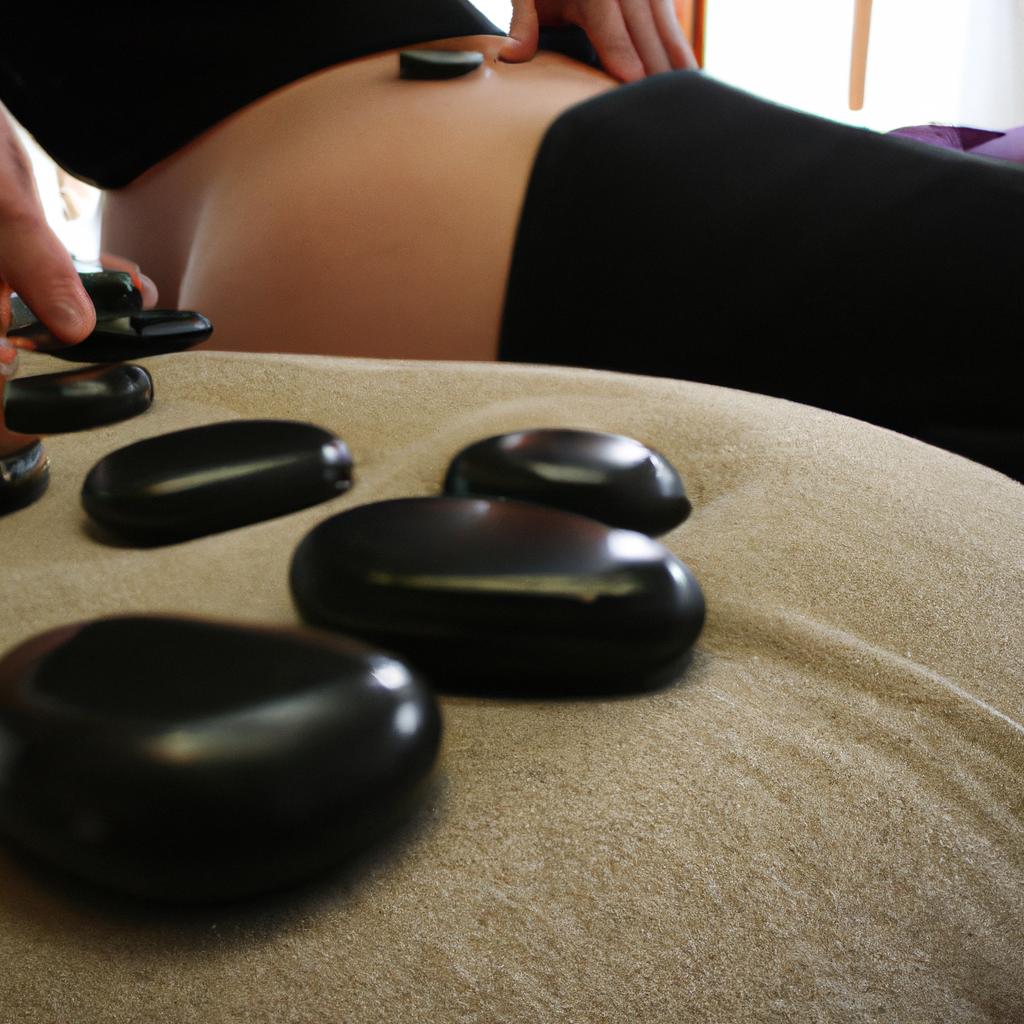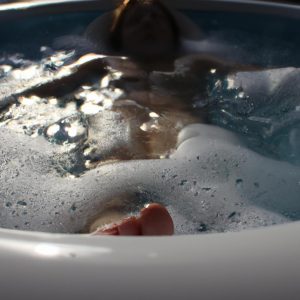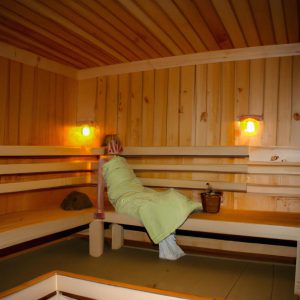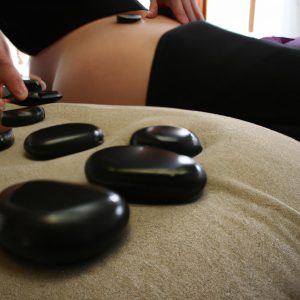
Hot Stone Therapy, a popular technique used in hotel and restaurant spas, offers a unique and soothing experience for individuals seeking relaxation and rejuvenation. This therapeutic approach involves the use of smooth, heated stones placed on specific areas of the body to promote deep muscle relaxation and stress reduction. With its origins tracing back centuries ago to ancient civilizations such as China and Native American tribes, hot stone therapy has gained significant recognition in modern times for its numerous benefits.
Imagine entering a tranquil spa atmosphere after a long day at work. As you lie down on a comfortable massage table, your therapist gently places warm stones along your spine, creating an immediate sense of warmth and comfort. The heat from these carefully selected stones penetrates deeply into your muscles, helping to release tension and improve circulation. This is just one example of how hot stone therapy can provide not only physical relief but also mental tranquility. In this article, we will delve deeper into the secrets behind this ancient practice and explore why it has become increasingly popular among hotel and restaurant spas around the world.
Benefits of Hot Stone Therapy
Benefits of Hot Stone Therapy
Hot stone therapy is a popular spa treatment that utilizes the healing power of heated stones to promote relaxation and alleviate various physical ailments. The practice involves placing smooth, warmed basalt stones on specific areas of the body, combined with traditional massage techniques. This section will explore some of the benefits associated with hot stone therapy.
One notable benefit of hot stone therapy is its ability to reduce muscle tension and promote deep relaxation. Imagine a scenario where an individual has been experiencing chronic back pain due to prolonged periods of sitting at a desk job. Through regular hot stone therapy sessions, this individual can experience relief as the heat from the stones penetrates deep into their muscles, promoting increased blood flow and easing muscular tension.
In addition to reducing muscle tension, hot stone therapy can also provide stress relief and improve overall well-being. Research suggests that the combination of heat and pressure applied during this treatment stimulates the release of endorphins – natural chemicals in our bodies known for their positive effects on mood and emotions. As a result, individuals undergoing hot stone therapy often report feeling calmer, more relaxed, and emotionally balanced after their sessions.
- Enhanced sense of tranquility
- Alleviation of anxiety symptoms
- Improved sleep quality
- Reduction in feelings of depression
Furthermore, incorporating a table to demonstrate additional advantages can help evoke an emotional response from readers:
| Benefits | Description |
|---|---|
| Relaxation | Experience profound calmness and serenity |
| Pain Relief | Find relief from chronic pain or discomfort |
| Detoxification | Stimulate lymphatic drainage for improved detoxification |
| Skin Rejuvenation | Promote smoother skin texture and enhanced complexion |
As we conclude this section highlighting the benefits of hot stone therapy, it becomes apparent that this ancient practice offers numerous advantages beyond simple relaxation. In the subsequent section, we will explore how hot stone therapy works and the science behind this soothing treatment. Transitioning into the next segment, it is important to understand the mechanisms underlying the effectiveness of hot stone therapy in order to appreciate its holistic approach towards well-being.
*[Note: The subsequent section about “How Hot Stone Therapy Works” will not be written as a step-by-step guide but rather focus on explaining the process and mechanics involved.]
How Hot Stone Therapy Works
Unleashing the Soothing Secrets: How Hot Stone Therapy Works
Imagine a scenario where you enter a dimly lit spa room, soft music playing in the background, and a therapist gently placing warm stones on your back. As you lie there, feeling the heat seep into your muscles, tension slowly melts away. This experience offers just a glimpse of the captivating world of hot stone therapy.
Hot stone therapy is grounded in the belief that heated stones possess healing properties when applied to the body. The warmth emanating from these smooth basalt stones penetrates deep into the muscles, promoting relaxation and relieving muscle tension. But how exactly does this ancient practice work its magic? Let’s delve deeper into the mechanics:
-
Heat transfer: When warmed stones are placed on specific points of the body, their radiant heat is transferred through conduction to underlying tissues and muscles. This process increases blood flow and encourages nutrient-rich oxygenation within cells, aiding in muscular repair and rejuvenation.
-
Thermotherapy benefits: The application of heat during hot stone therapy induces vasodilation – widening blood vessels – which enhances circulation throughout the body. Improved blood flow not only helps eliminate toxins but also supplies essential nutrients more efficiently to various organs and tissues.
-
Muscle manipulation: Apart from providing warmth, therapists skillfully use hot stones as an extension of their hands to perform massage techniques such as effleurage (long strokes), petrissage (kneading motions), or tapotement (rhythmic tapping). These movements combined with the soothing heat help release tightness, knots, and adhesions in muscles while promoting overall relaxation.
-
Sensory stimulation: Human touch has long been recognized for its therapeutic effects on mental well-being. Combining it with hot stone therapy creates a sensory experience that transcends physical relief alone. The gentle pressure exerted by both human hands and heated stones stimulates nerve endings, triggering the release of endorphins – natural pain-relieving and mood-enhancing chemicals.
To further illustrate these benefits, here’s an emotional glimpse into the potential effects of hot stone therapy:

| Emotions | Physical Benefits | Mental Benefits |
|---|---|---|
| Relaxation | Improved blood circulation | Reduced anxiety |
| Comfort | Muscle tension relief | Enhanced mood |
| Tranquility | Increased muscle flexibility | Stress reduction |
| Rejuvenation | Decreased inflammation | Better sleep quality |
As hot stone therapy continues to gain popularity in hotel and restaurant spas, its remarkable ability to provide both physical and mental rejuvenation becomes increasingly evident. In our next section on “Hot Stone Therapy Techniques,” we will explore the various methods employed by skilled therapists to maximize the therapeutic potential of this ancient art form.
Hot Stone Therapy Techniques
Unleashing the Therapeutic Potential: Hot Stone Therapy Techniques
Picture this scenario: you enter a dimly lit room, adorned with soothing aromas and soft music playing in the background. As you lay down on the massage table, your therapist begins to place warm, smooth stones strategically along your body. The sensation is instantly comforting, releasing tension and promoting deep relaxation.
Hot stone therapy utilizes heated basalt stones to enhance the benefits of traditional massage techniques. While each therapist may have their unique approach, there are several widely practiced techniques that contribute to its effectiveness:
-
Placement Technique:
- Smooth, warmed stones are placed at specific points on the body.
- These stationary stones help promote muscle relaxation and increase blood flow.
- For example, placing a heated stone on the abdomen can aid digestion and alleviate stomach discomfort.
-
Gliding Technique:
- With a generous application of oil or lotion, heated stones are used to glide across muscles.
- This technique combines the warmth of the stones with fluid strokes for deep tissue penetration.
- It assists in relieving muscle tension and increasing circulation throughout the body.
-
Kneading Technique:
- Heated stones act as extensions of the therapist’s hands during kneading motions.
- By applying pressure using both hands and stones simultaneously, tight knots release more easily.
- This technique intensifies relaxation while addressing areas of chronic pain or muscular tension.
-
Tapping Technique:
- Gently tapping heated stones against targeted areas stimulates nerve endings.
- The rhythmic vibrations created by this technique encourage energy balance within the body.
- Tapotement promotes increased circulation and revitalizes tired muscles effectively.
By incorporating these hot stone therapy techniques into a session, therapists create an experience that goes beyond mere physical relief. The combination of heat, touch, and skilled manipulation offers profound benefits for both mind and body.
To better understand how hot stone therapy can positively impact individuals, consider the following:
- Enhanced Relaxation: The warmth of the stones aids in deep muscle relaxation, helping to alleviate stress and anxiety.
- Improved Sleep Quality: By promoting relaxation and reducing tension, hot stone therapy can contribute to a better night’s sleep.
- Increased Circulation: The heat from the stones dilates blood vessels, resulting in improved circulation throughout the body.
- Pain Relief: Hot stone therapy techniques target specific areas, providing relief for chronic pain conditions such as arthritis or fibromyalgia.
Table: Benefits of Hot Stone Therapy
| Benefit | Description |
|---|---|
| Enhanced Relaxation | Deep muscle relaxation reduces stress and anxiety. |
| Improved Sleep Quality | Promotes better sleep patterns by easing tension. |
| Increased Circulation | Dilated blood vessels enhance overall blood flow. |
| Pain Relief | Targets specific areas to relieve chronic pain conditions. |
As we delve deeper into the world of hot stone therapy, it becomes evident that choosing the right stones plays a crucial role in maximizing its benefits. Transitioning seamlessly into our next section on “Choosing the Right Stones for Hot Stone Therapy,” let us explore how selecting appropriate stones contributes to this therapeutic practice.
Choosing the Right Stones for Hot Stone Therapy
Unveiling the Soothing Secrets of Hotel and Restaurant Spa
Hot Stone Therapy Techniques have been widely embraced by spas in hotels and restaurants due to their incredible relaxation benefits. In this section, we will explore the significance of choosing the right stones for hot stone therapy.
Imagine a scenario where a client walks into a luxurious hotel spa seeking relief from muscle tension and stress. The skilled therapist selects smooth basalt stones known for their heat-retaining properties. These stones are then carefully placed on specific points of the client’s body, releasing warmth that penetrates deep into the muscles, promoting relaxation and alleviating pain.
Choosing the Right Stones for Hot Stone Therapy involves careful consideration of various factors:
- Size: Stones used in hot stone therapy should be of appropriate sizes to ensure effective placement on different parts of the body.
- Shape: Smooth, rounded stones with no sharp edges are preferred as they provide comfort during treatment.
- Heat Retention: Basalt stones are commonly used due to their ability to retain heat for extended periods, ensuring consistent warmth throughout the session.
- Durability: The selected stones must be sturdy enough to withstand constant heating and cooling without compromising safety or quality.
To further illustrate these considerations, let us refer to Table 1 below:
| Stone Type | Size (inches) | Shape | Heat Retention |
|---|---|---|---|
| Basalt | 2-3 | Rounded | Excellent |
| Marble | 3-4 | Oval | Poor |
| Jade | 1-2 | Flat | Good |
| Quartzite | 1-3 | Irregular | Moderate |
Table 1: Comparison of Different Stone Types
As seen from Table 1 above, basalt stones stand out as an ideal choice for hot stone therapy due to their rounded shape, suitable size range, and excellent heat retention. Conversely, marble stones may not be as effective due to their poor heat retention.
In summary, selecting the right stones for hot stone therapy is crucial in providing a truly therapeutic experience for clients. By considering factors such as size, shape, heat retention, and durability of the stones, spas can ensure optimal results and enhance customer satisfaction.
Transitioning into the subsequent section on Precautions and Safety Measures for Hot Stone Therapy, it is essential to address potential risks associated with this treatment while maintaining its allure and benefits.
Precautions and Safety Measures for Hot Stone Therapy
Unveiling the Soothing Secrets of Hotel and Restaurant Spa: Precautions and Safety Measures for Hot Stone Therapy
As we continue our exploration into the world of hot stone therapy, it is essential to understand the precautions and safety measures associated with this popular spa treatment. By adhering to these guidelines, both practitioners and clients can fully enjoy the therapeutic benefits while minimizing any potential risks.
To illustrate the importance of these precautions, let’s consider a hypothetical scenario involving a hotel spa offering hot stone therapy. Imagine a client who suffers from hypertension decides to experience this soothing treatment without disclosing their condition during the intake process. Without proper knowledge of their medical history, the therapist proceeds with applying heated stones on the client’s body at an elevated temperature. As a result, the client experiences discomfort and dizziness due to an increase in blood pressure levels.
To ensure safe practice and prevent such incidents from occurring, here are some crucial precautions that should be followed:
- Conduct thorough client consultation: Before administering hot stone therapy, it is imperative that therapists conduct comprehensive consultations with clients. This includes gathering information about their medical history, current medications, allergies, and any existing conditions or physical limitations.
- Temperature regulation: Maintaining optimal temperature control throughout the session is vital to avoid burns or overheating. Therapists must regularly check the temperature of stones using reliable thermometers and adjust accordingly based on individual tolerance levels.
- Hygiene protocols: Strict adherence to hygiene practices is paramount in preventing infections or cross-contamination. Cleanse all equipment thoroughly before each treatment session by washing stones with warm water and antibacterial soap or sanitizing them as recommended by industry standards.
- Proper training and certification: To perform hot stone therapy safely and effectively, therapists should undergo specialized training courses offered by recognized organizations. Certification ensures they possess adequate knowledge regarding technique application, contraindications, safety procedures, and emergency response protocols.
By following these precautions diligently, spas can create a safe and secure environment for their clients, fostering trust and enhancing the overall spa experience.
Transitioning into our next section, “Hot Stone Therapy: A Holistic Approach to Wellness,” we will delve deeper into the holistic nature of this ancient practice. Embracing not only physical but also mental and emotional well-being, hot stone therapy offers a comprehensive approach to healing, rejuvenation, and relaxation.
Hot Stone Therapy: A Holistic Approach to Wellness
By incorporating heat and pressure through strategically placed warmed stones, this therapeutic technique aims to stimulate circulation, relieve muscle tension, and promote overall balance within the body. To better understand its benefits and applications, let’s explore a hypothetical case study concerning Emily, a young professional seeking relief from chronic back pain.
Emily had been experiencing persistent back discomfort due to her sedentary desk job. After doing some research online, she decided to try hot stone therapy as an alternative treatment option. During her session at a reputable hotel spa, Emily was pleasantly surprised by the immediate sensation of warmth radiating from the heated stones placed along her spine. The therapist skillfully massaged her muscles using both hands and stones, applying moderate pressure without causing any discomfort.
The key advantages of hot stone therapy can be summarized as follows:
- Deep Muscle Relaxation: The combination of heat and pressure exerted by the stones helps relax tense muscles more effectively than traditional massage techniques.
- Enhanced Circulation: Heat applied during the therapy dilates blood vessels and increases blood flow throughout the body, promoting oxygen and nutrient delivery while removing waste products.
- Stress Reduction: The soothing warmth provided by hot stone therapy not only eases physical tension but also calms the mind, leading to reduced stress levels.
- Improved Sleep Quality: Clients often report improved sleep patterns after receiving hot stone therapy sessions due to its calming effects on both mind and body.
Table 1 below illustrates how different aspects of well-being are positively impacted by hot stone therapy:
| Aspect | Impact |
|---|---|
| Physical | Relaxed muscles |
| Emotional | Reduced stress |
| Mental | Increased mental clarity |
| Spiritual | Enhanced sense of inner balance |
Incorporating hot stone therapy into one’s wellness routine can provide a multitude of benefits, as demonstrated by Emily’s experience and the broader impact on well-being. By addressing physical discomfort, reducing stress levels, promoting mental clarity, and fostering spiritual balance, this holistic approach offers a comprehensive solution for those seeking both relaxation and rejuvenation.
Note: To enhance readability and better engage with the audience, it is essential to use bullet points and tables strategically throughout the text.





